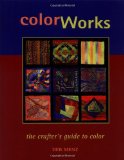|
Color Works: The Crafter's Guide to ColorColor Works: The Crafter's Guide to Color by Deb Menz, published by Interweave Press, 2004. 115 pages plus a tear-out color wheel, gray scale, and other color charts A Book Review
What is remarkable and appealing about Color Works, The Crafter's Guide to Color, is the way Deb Menz takes each concept and writes a brief page about it and places that page opposite a page with samples illustrating the concept in each of nine creaft media. The media covered are handspun yarn, fair isle knitting, weaving on a hand-painted warp, hand embroidery, surface design, machine embroidery, pieced quilting, paper collage, and, of course, bead embroidery. The design of these small square samples remains the same throughout the book, as the color changes to illustrate each concept. There are 28 of these 2-page spreads. They start out describing color, by hue, value, and saturation. Then Menz covers basic color relationships, including the color wheel, complex colors, warm and cool colors, undertones, undertones with neutrals, alanagous colors, and complementary colors. Then it's on to value, in major and minor keys. This is followed by various types of color contrast, and finally by color harmonies. For each concept in Color Works, we get the nine squares of craft work, clear explanations, plus additional graphics to fully clarify the concept. All together, this section makes up two-thirds of the book, and the pages are both good to look at and great to learn from. But Wait, There's More. . .No, I'm not telling you about all the bonuses you'll get if you order Ginsu knives, but there is more to Menz's Color Works. Because she has a section on the various craft media. For beads, this means a discussion of bead finishes, illustrated with a photo of 14 samples of seed beads. Each sample consists of three rows, about 2 inches long -- so there are enough of each type of bead to show hoe the finishes compare. For each of her nine media, she has a finished sample that shows how she selects a particular color harmony from color theory, works it out with paper color swatches, then with grayscale swatches, and finally with beads. Of course, I had to go first to the beaded sample, but then I took the time to look at the illustrations in all nine media and was able to learn a lot from each of them. Nifty Color Tools to Tear OutThe back of Color Works has tear-out pages printed on cardstock, so you can use them to play around with your own color ideas. There is also a pocket mounted on the inside back cover so you can keep your torn out pages tidily with the book. A particularly nice touch with the tear-outs is that two of them are duplicated in the bound portion of the book; both the color wheel and a grayscale will remain in the book even after you remove the tear-out pages. Color Works, the Crafter's Guide to Color is spiral bound, with the wire binding hidden behind hard board covers. It is beautifully designed and produced. It is a pleasure to page through all of the color samples, looking at the beadwork and also at all the other crafts, as each sample has something else to tell you about whichever concept is being covered. RecommendationsI really like this book for its clear explanation of color concepts. For me, the pages with nine crafted samples illustrating each point helped me sort out the general concept from the quirkiness of any single sample. For example, to illustrate a discussion of warm and cool colors, she has samples that use both warm and cool colors. The differences between the samples (in brightness, or contrast, or even the particular hues chosen) shows the variation possible in warm/cool combinations but doesn't stick you with thinking that all warm/cool combos should look a lot like one particula example. Take a look at the illustration on the cover. It is a reproduction of the page on Triad Harmony and all the samples use a triad of yellow-green, red-orange, and blue-violet. But the one at top right is very pale, while the one under it is dark. The bead embroidery sample in the center has a lot of light-to-dark contrast, and each of the nine varies from the others while staying within the color harmony Menz has selected. You might enjoy just flipping through this book and noticing which squares really catch your eye, and which you have to look at for a while to fully appreciate. You can learn more about your natural preferences so you can use them more deliberately, and you can stretch yourself to pay more attention to aspects of color that are less familiar. If you go to Amazon, you can see some pages from Color Works: The Crafter's Guide to Color, If you are serious about bead art then this is a book to own, not just borrow. You will keep coming back to it, and keep learning from it. Return to The Beading Book Shelf
|

